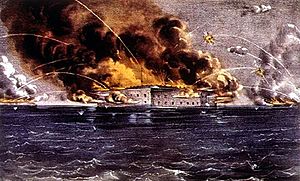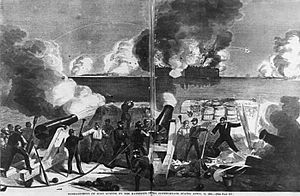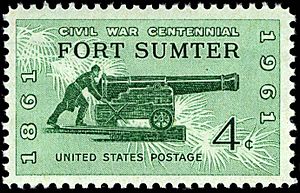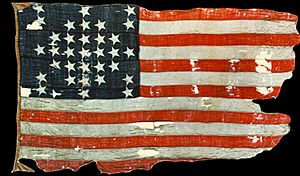Battle of Fort Sumter facts for kids
Quick facts for kids Battle of Fort Sumter |
|||||||
|---|---|---|---|---|---|---|---|
| Part of the American Civil War | |||||||
 Bombardment of Fort Sumter by Currier & Ives |
|||||||
|
|||||||
| Belligerents | |||||||
| Commanders and leaders | |||||||
| Robert Anderson | P. G. T. Beauregard | ||||||
| Units involved | |||||||
| 1st United States Artillery | Provisional Forces of the Confederate States | ||||||
| Strength | |||||||
| 85 | 500–6,000 (estimated) | ||||||
| Casualties and losses | |||||||
| 0 | 0 | ||||||
The Battle of Fort Sumter was a short but very important attack on Fort Sumter. It happened in Charleston Harbor, South Carolina, from April 12 to April 13, 1861. This battle officially started the American Civil War.
Contents
Why Did Southern States Secede?
After Abraham Lincoln was elected president in 1860, seven Southern states decided to leave the United States. South Carolina was the first to do this. By February 1861, these states had formed their own country, called the Confederate States of America. This happened before Lincoln even became president.
Confederate forces took control of many federal forts and buildings in the South. Most of the time, they did this without a fight. However, a few forts stayed under Union control. These included Fort Monroe in Virginia, Fort Pickens in Florida, and Fort Sumter in South Carolina.
The Siege of Fort Sumter Begins

On December 20, 1860, South Carolina declared it was leaving the United States. Its leaders then demanded that the U.S. Army leave its forts in Charleston Harbor. The United States government did not agree that secession was legal, so they refused.
On December 26, Major Robert Anderson of the U.S. Army made a secret move. He moved his small group of soldiers from Fort Moultrie to Fort Sumter. Fort Moultrie was weak, but Fort Sumter was a strong fortress. It was built on an island and controlled the entrance to Charleston Harbor.
U.S. President James Buchanan tried to send more soldiers and supplies to Major Anderson. He used an unarmed merchant ship called the Star of the West. But the attempt failed. Confederate cannons on the shore fired at the ship on January 9, 1861. After this, South Carolina took control of all federal property in the Charleston area, except for Fort Sumter.
In the early months of 1861, the situation around Fort Sumter became like a siege. This means the fort was surrounded and cut off. In March, Brigadier General P. G. T. Beauregard took command of the Confederate forces in Charleston. He was the first general of the new Confederate States Army. Beauregard worked hard to make the Confederate cannons around Charleston Harbor stronger. These cannons were all aimed at Fort Sumter. The Union soldiers inside Fort Sumter tried to add more cannons. But it was hard because they did not have enough men, food, or supplies.
The Attack and Surrender
President Abraham Lincoln had just been elected in November 1860. When he took office, he faced a big problem. He needed to get supplies to the Union soldiers at Fort Sumter. President Lincoln told the Governor of South Carolina, Francis W. Pickens, that he was sending supply ships.
In response, the Confederate government demanded that Fort Sumter be emptied right away. Major Anderson of the Union army refused to leave. So, at 4:30 a.m. on April 12, the Confederates began to fire on the fort. They used their cannons from batteries (groups of cannons) all around the harbor.
The Union fort fired back, but they were greatly outnumbered in terms of cannons. After 34 hours of fighting, Major Anderson agreed to leave the fort. No one died directly from the battle itself. However, during the surrender ceremony on April 14, a cannon exploded. This accident caused two Union soldiers to die.
What Happened After the Battle?
After the battle, many people in both the North and the South felt that more fighting was needed. President Lincoln quickly asked for 75,000 volunteers to stop the Southern states from leaving. This led to four more Southern states also leaving the United States and joining the Confederacy.
The Battle of Fort Sumter is known as the first battle that started the American Civil War.
On April 14, 1865, exactly four years after he lowered it in surrender, Major General Anderson raised the Fort Sumter Flag again. He raised it over the damaged remains of the fort.
Fun Facts About Fort Sumter
- The Battle of Fort Sumter officially started the American Civil War.
- The meaning of the American flag became very important after this battle. It became a powerful symbol of patriotism. About 100,000 flags were quickly displayed across the country. It was the first time the flag had been made in such large numbers.
- Controlling Fort Sumter helped the Confederates create a gap in the Union blockade. A blockade is when ships stop other ships from entering or leaving a port.
- The battle lasted for 2 days.
- P. G. T. Beauregard, who led the Confederate forces, was trained at West Point. One of his teachers there was Robert Anderson. Anderson was the commander of Fort Sumter and surrendered to Beauregard.
Images for kids
-
Brig. Gen. P. G. T. Beauregard
-
Our Banner in the Sky (1861) by Frederic Edwin Church
See also
 In Spanish: Batalla de Fort Sumter para niños
In Spanish: Batalla de Fort Sumter para niños
















